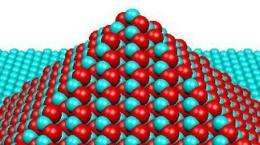Good vibrations for future quantum computers

(PhysOrg.com) -- The enigmatic quantum dot is the basic building block for quantum computers. EPFL physicists have developed a new theory which shows that dot symmetry is enough to account for most of their intriguing optical properties.
Physicists have created a pyramidal dot that’s just shy of 100 nanometers high, about 200 atoms on a side. By applying voltage to this miniature structure, the scientists have created a device that can emit light, which could then be used in future components of quantum computers. But the road to this new kind of computing is still long, particularly because determining the optical properties of these quantum dots is a complicated and computationally intensive endeavor. Marc-André Dupertuis and his team from EPFL’s Laboratory of Physics of Nanostructures have proposed, and observationally verified, a new physical theory that not only reduces the time needed to perform these calculations, but also, and above all, allows us simply to better understand the nature of these strange objects.
When electrical charges are injected into quantum dots, they start to vibrate. This is what physicists call the wave function, which in this case vibrates a bit like the head of a drum. One would think that simulating these vibrations would be extremely complex, but Dupertuis realized that the wave behavior, and thus the light emitted by the quantum dot, could be determined sufficiently by symmetry. Because of this, the calculation could be simplified using a familiar mathematical tool known as group theory.
Better understanding on the back of a napkin
The strength of this approach is its relative simplicity. The physicists can deduce the optical properties of quantum dots based on symmetries that they suspect are there, and then verify the presence of the symmetries experimentally. “Calculations that up to now required supercomputers can now be replaced by other calculations that can be done on the back of a napkin,” Dupertuis says.
Dupertuis had to overcome a serious difficulty in order to come up with the theory – he had to be able to simplify it sufficiently, while still taking into account the strange properties that govern the quantum world. Imagine a cake cut into symmetric slices, but whose edges don’t all look the same; you’d have to arrange the slices in a specific order to put the cake back together again. This is the kind of mathematical and quantum challenge that the physicist is tackling.
A promising advance
This obstacle aside, the method is very promising. “Using proven observational methods, we can precisely deduct the exact symmetry of the quantum dot, as well as the properties of the electrical charge it contains and even what kind of photons it will emit.” This information will be useful in designing new devices that could be used in quantum computers.
More information: Symmetries and the polarized optical spectra from exciton complexes in quantum dots, M. A. Dupertuis, K. F. Karlsson, D. Y. Oberli, et al., Physical Review Letters, 06.09.2011
Provided by Ecole Polytechnique Federale de Lausanne




















